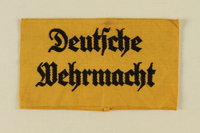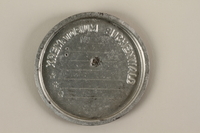Overview
- Brief Narrative
- Scrip, valued at 20 kronen, issued in the Theresienstadt (Terezin) ghetto-labor camp in 1943. All currency was confiscated from deportees upon entry and replaced with scrip and ration coupons that could be exchanged only in the camp. The Theresienstadt camp existed for 3.5 years, from November 24, 1941 to May 9, 1945. It was located in a region of Czechoslovakia occupied by Germany, renamed the Protectorate of Bohemia and Moravia, and made part of the Greater German Reich.
- Date
-
issue:
1943 January 01
- Credit Line
- United States Holocaust Memorial Museum Collection, Gift of Bernard Feingold
- Markings
- front, upper center, printed in green ink : QUITTUNG ÜBER / ZWANZIG KRONEN [RECEIPT OF / TWENTY CROWNS]
front, lower center, printed in middle text then above in green ink : 20
front, lower center, smaller text than above, printed in green ink : WER DIESE QUITTUNG VERFÄLSCHT ODER NACHMACHT / ODER GEFÄLSCHTE QUITTUNGEN IN VERKEHR BRINGT. / WIRD STRENGSTENS BESTRAFT [ANYONE WHO FALSIFIES OR DISTORTS OR FAKES THIS RECEIPT, OR COUNTERFEITS RECEIPT, WILL BE STRICTLY PUNISHED]
reverse, upper left in border, serial number, printed in red ink : 004085
reverse, right center below scrollwork, series number, printed in red ink :
reverse, center, printed in green ink : Quittung / über / ZWANZIG KRONEN [Receipt / of / TWENTY CROWNS]
reverse, lower center, printed in black ink : THERESIENSTADT, AM 1.JANNER 1943 DER ALTESTE DER JUDEN / IN THERESIENSTADT [THERESIENSTADT, ON 1. JANUARY 1943 THE ELDER OF THE JEWS IN THERESIENSTADT]
reverse, bottom right, printed in black ink : Jakob Edelstein
Physical Details
- Language
- German
- Classification
-
Exchange Media
- Category
-
Money
- Object Type
-
Scrip (aat)
- Physical Description
- Rectangular paper scrip. The front has a graphic design in black and green ink on a green background. The front depicts Moses holding 2 stone tablets with the 10 Commandments in Hebrew characters in a medallion on the left, with German text on the right. The right side has a wide, off-white border with the denomination 20 in the lower corner and a 6-pointed Star of David above. The reverse has a green geometric background design with German text, and a scrollwork line. Below the text is an engraved signature. The denomination 20 is in the upper right corner. The left side has a wide, off-white border with the denomination 20 in the lower corner with a 6-pointed Star of David above. The serial number is in the upper left corner. The series number is on the right, center under the scrollwork.
- Dimensions
- overall: Height: 2.625 inches (6.668 cm) | Width: 5.250 inches (13.335 cm)
- Materials
- overall : paper, ink
Rights & Restrictions
- Conditions on Access
- No restrictions on access
- Conditions on Use
- No restrictions on use
Keywords & Subjects
Administrative Notes
- Legal Status
- Permanent Collection
- Provenance
- The Theresienstadt scrip was donated to the United States Holocaust Memorial Museum in 1989 by Bernard Feingold.
- Record last modified:
- 2022-07-28 18:24:20
- This page:
- https://collections.ushmm.org/search/catalog/irn18330
Download & Licensing
In-Person Research
- By Appointment
- Request 21 Days in Advance of Visit
- Plan a Research Visit
- Request to See This Object
Contact Us
Also in Bernard Feingold collection
The collection consists of artifacts relating to the experiences of Brigadier General Bernard Feingold during World War II.
Date: 1914-1941
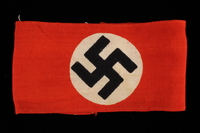
Armband
Object
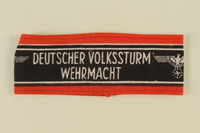
Deutscher Volkssturm Wehrmacht armband
Object
Deutscher Volkssturm Wehrmacht [German People’s Militia] brassard. This militia was not part of the army, but was organized late in the war by the Nazi Party per Hitler's orders of September 25, 1944. It was composed of males who had been exempted from home guard and military service because of age or health.
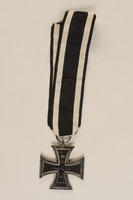
WWI Iron Cross 2nd Class medal awarded to a Jewish veteran
Object
The Iron Cross was awarded to Walter Joseph, a German Jew, for his military service in World War I.

WWI Iron Cross 2nd Class medal awarded to a Jewish veteran
Object
The Iron Cross was awarded to Walter Joseph, a German Jew, for his military service in World War I.
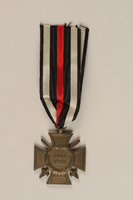
WWI Hindenburg Cross Medal awarded to a German Jewish veteran
Object
The Hindenburg Cross (a.ka., German Cross of Honor) was awarded to Walter Joseph, a German Jew, for his military service in World War I.
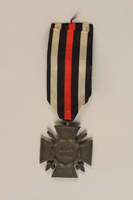
Honor Cross of the World War 1914/1918 combatant veteran service medal awarded to a German Jewish veteran
Object
Das Ehrenkreuz des Weltkriegs 1914 1918 [The Honor Cross of World War 1914/1918) awarded for serving in combat in the German Army during the First World War. The award was established by President Paul von Hindenburg, on July 13, 1934. This was the first official WWI service medal of the Third Reich, often referred to by an unofficial name, Hindenburg Cross. Hindenburg, Field Marshal of German forces during WWI, appointed Hitler as Chancellor in January 1933, and soon a Nazi dictatorship ruled the country.
Buchenwald Standort-Kantine concentration camp scrip, 2 Reichsmark, given to and inscribed by a US soldier
Object
2 Reichsmark Buchenwald Kantine coupon given to Bernard Feingold, a US soldier, by a Russian Jewish inmate in exchange for two cigarettes. Feingold inscribed the note with story of its receipt. In early April 1945, as US forces approached Buchenwald concentration camp, the German guards began to evacuate the camp. On April 11, the prisoners revolted and seized control of the camp. Later that day, soldiers from the Sixth Army Armored Division, part of the Third Army, arrived in camp and discovered more than 21,000 starved and ill inmates.
Theresienstadt ghetto-labor camp scrip, 100 kronen note
Object
Scrip, valued at 100 kronen, issued in the Theresienstadt (Terezin) ghetto-labor camp in 1943. All currency was confiscated from deportees upon entry and replaced with scrip and ration coupons that could be exchanged only in the camp. The Theresienstadt camp existed for 3.5 years, from November 24, 1941 to May 9, 1945. It was located in a region of Czechoslovakia occupied by Germany, renamed the Protectorate of Bohemia and Moravia, and made part of the Greater German Reich.
Theresienstadt ghetto-labor camp scrip, 50 kronen note
Object
Scrip, valued at 50 kronen, issued in the Theresienstadt (Terezin) ghetto-labor camp in 1943. All currency was confiscated from deportees upon entry and replaced with scrip and ration coupons that could be exchanged only in the camp. The Theresienstadt camp existed for 3.5 years, from November 24, 1941 to May 9, 1945. It was located in a region of Czechoslovakia occupied by Germany, renamed the Protectorate of Bohemia and Moravia, and made part of the Greater German Reich.
Theresienstadt ghetto-labor camp scrip, 10 kronen note
Object
Scrip, valued at 10 kronen, issued in the Theresienstadt (Terezin) ghetto-labor camp in 1943. All currency was confiscated from deportees upon entry and replaced with scrip and ration coupons that could be exchanged only in the camp. The Theresienstadt camp existed for 3.5 years, from November 24, 1941 to May 9, 1945. It was located in a region of Czechoslovakia occupied by Germany, renamed the Protectorate of Bohemia and Moravia, and made part of the Greater German Reich.
Theresienstadt ghetto-labor camp scrip, 5 kronen note
Object
Scrip, valued at 5 kronen, issued in the Theresienstadt (Terezin) ghetto-labor camp in 1943. All currency was confiscated from deportees upon entry and replaced with scrip and ration coupons that could be exchanged only in the camp. The Theresienstadt camp existed for 3.5 years, from November 24, 1941 to May 9, 1945. It was located in a region of Czechoslovakia occupied by Germany, renamed the Protectorate of Bohemia and Moravia, and made part of the Greater German Reich.
Theresienstadt ghetto-labor camp scrip, 2 kronen note
Object
Scrip, valued at 2 kronen, issued in the Theresienstadt (Terezin) ghetto-labor camp in 1943. All currency was confiscated from deportees upon entry and replaced with scrip and ration coupons that could be exchanged only in the camp. The Theresienstadt camp existed for 3.5 years, from November 24, 1941 to May 9, 1945. It was located in a region of Czechoslovakia occupied by Germany, renamed the Protectorate of Bohemia and Moravia, and made part of the Greater German Reich.
Theresienstadt ghetto-labor camp scrip, 1 krone note
Object
Scrip, valued at 1 krone, issued in the Theresienstadt (Terezin) ghetto-labor camp in 1943. All currency was confiscated from deportees upon entry and replaced with scrip and ration coupons that could be exchanged only in the camp. The Theresienstadt camp existed for 3.5 years, from November 24, 1941 to May 9, 1945. It was located in a region of Czechoslovakia occupied by Germany, renamed the Protectorate of Bohemia and Moravia, and made part of the Greater German Reich.

